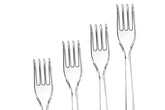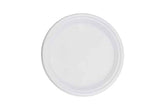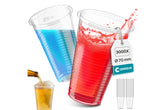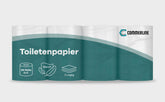paper plate
-
Paper plate, round, KU18
Our round paper plates, model KU18, are an excellent choice for your next event: Product details : Diameter: 18 cm Color: Snow white Packaging: Each carton contains 1000 pieces, divided into packages of 100 pieces each. Sustainability in focus : Made from environmentally friendly,...- From €3,90
€0,00- From €3,90
- Unit price
- per
-
Round paper plate, Ø 23 cm
Practical disposable paper plates – 23 cm for every occasion Our 23 cm disposable paper plates are the ideal solution for events, parties, or picnics. They are made from high-quality, eco-friendly material and are both sturdy and lightweight. These plates are not only practical...- From €4,90
- From €4,90
- Unit price
- per
-
Paper plate, round, Ø 26 cm
Discover our practical paper plates, ideal for every occasion. These round paper plates, measuring 26 cm in diameter, are perfect for parties, picnics, or everyday use. Made from sturdy cardboard, they are both environmentally friendly and user-friendly. Our paper plates are an excellent alternative...- From €7,90
- From €7,90
- Unit price
- per
-
Paper plate, round, Ø 28 cm,
1. Compact size and stability : Our round paper plate 28 impresses with its handy design and stable structure for reliable use. 2. Sustainable materials : The round paper plate 28 is made from environmentally friendly and sustainable materials to actively contribute to the...- From €7,99
€0,00- From €7,99
- Unit price
- per
-
Paper plate, round, Ø 32 cm
1. Robust size and stability : Our round paper plate 32 impresses with its generous design and stable structure for long-lasting use. 2. Environmental awareness : The round paper plate 32 is made of environmentally friendly and sustainable material, which actively contributes to the...- From €9,99
- From €9,99
- Unit price
- per
-
French fries bowls, KU1
Robustness and durability : Our Ku1 fries bowl is characterized by its solid construction, which ensures a long service life. Environmental friendliness : The Ku1 fries bowl is made of environmentally friendly material and thus actively contributes to the protection of our environment. Recyclable...- From €8,50
€8,99- From €8,50
- Unit price
- per
-
French fries bowl, KUOB
1. Compact stability : Our KUOB French fry bowl is characterized by its robust construction, which ensures long-lasting use. 2. Environmental friendliness : The KUOB French fry bowl is made of environmentally friendly material and makes an active contribution to environmental protection. 3. Sustainable...- From €8,70
- From €8,70
- Unit price
- per
-
Chips bowl, KU41 17.5x13x3
1. Robust size and stability : Our KU41 French fry bowl impresses with its generous design and a stable structure for long-lasting use. 2. Environmental awareness : The KU41 French fry bowl is made of environmentally friendly material and actively contributes to the protection...- From €9,99
- From €9,99
- Unit price
- per
-
Chip bowl, KU51
1. Stable size and robustness : Our KU51 French fry bowl impresses with its generous design and a stable structure for long-lasting use. 2. Environmental awareness : The KU51 French fry bowl is made of environmentally friendly and sustainable material, which actively contributes to...- From €7,90
- From €7,90
- Unit price
- per
-
Rectangular paper plate 16 x 23 cm
Rectangular paper plates, 16 x 23 cm, are ideal for disposable use at events, catering, and everyday use in bakeries, snack bars at gas stations, and pastry shops. This practical and highly sought-after size is packaged in cartons of 4 x 250 plates. Material...- From €13,99
€0,00- From €13,99
- Unit price
- per
-
Rectangular paper plates – 13 x 20 cm
Our rectangular paper plates offer a practical and environmentally friendly solution for your events and catering services: Product details : Size: 13 x 20 cm Color: Classic White Contents: 1500 pieces per carton, divided into 6 packages of 250 pieces each Packaging unit: carton...- From €6,99
- From €6,99
- Unit price
- per
-
Rectangular paper plate, 10 x 16 cm
Discover our rectangular paper plates, perfect for events and catering: Product details : Size: 10 x 16 cm Color: Pure white Contents: 3000 pieces per carton, divided into 12 packages of 250 pieces each Packaging unit: carton Commitment to the environment : Made from...- From €5,90
- From €5,90
- Unit price
- per






















